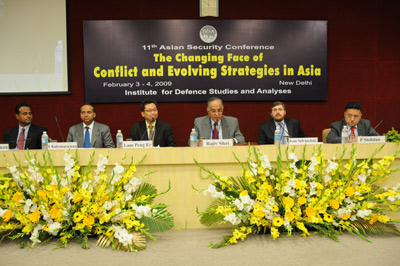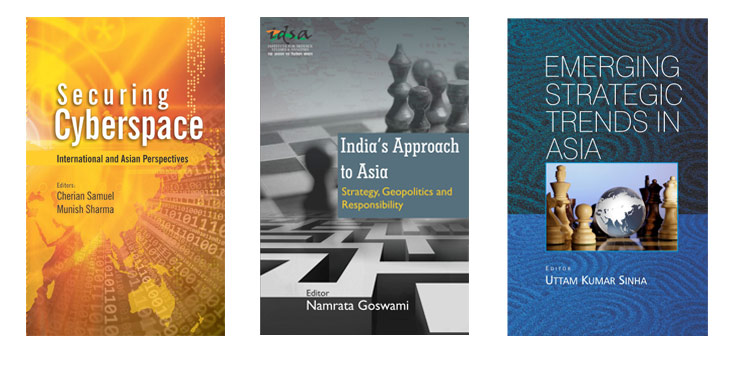You are here
11th Asian Security Conference on "The Changing Face of Conflict and Strategy in Asia"
Rapporteur’s Report on Session V
February 04, 2009
Security Strategies of Major Powers in Asia
Prepared by Prof. Stobdan and Dr. Shanthie Mariet D’Souza

This session chaired by Mr. Rajiv Sikri involved lucid presentations by four speakers on the theme “Security Strategies of Major Powers in Asia”. In the first presentation, Dr. Ivan Safranchuk delved on the “The competition for security roles in Central Asia” by highlighting the growing role of ‘gas’ in Asia’s emerging markets. In bringing out the differences between Russia’s long-term strategy and US market strategy for redistribution of oil and gas, he emphasised on the positive aspects of long-term strategy. He pointed out China’s new plans in Central Asia, in the emerging new great game in central Asia. Importantly, India has energy cooperation agreement with both Kazakhstan and Turkmenistan. However, it is plagued by slow progress, he pointed out. India has almost no opportunity of getting gas from Central Asia due to the security and geopolitical problematic plaguing the Afghanistan route. While Russia has no direct concerns with developments in Afghanistan, the project of “greater Central Asia’ connected by energy infrastructure remains worrisome for Russia. Dr. Srafanchuk also brought to light that Russia has set no conditions for NATO’s transit route from its territory to North Afghanistan.
In his paper titled “Japan’s Security Policy in an Uncertain World: Evolution and Innovation”, Dr LAM Peng Er delved on the main framework of Japan’s security policy. Importantly, this policy appears to be enduring despite developments like the end of the Cold War, adherence to the US-Japan Alliance and a “minimalist” approach to defense matters as obliged by its pacifist constitution, domestic politics and norms. He highlighted Japan’s shift away from a passive “one country pacifism” because of its desire to play a larger political role commensurate with its economic power. However, it is also true that Japan cannot become a great military power which can settle international disputes by force, he maintained. Tokyo seeks to play a larger political and security role in East Asia, especially in the areas of anti-piracy maritime security in Southeast Asia, human security and peace-building. Such a role has domestic as well as regional acceptability. The consolidation of peace is a good option for Japan to play a larger political role to address civil wars and post-conflict processes to burnish its identity as an active and responsible “peace loving” state. Indeed, Japan is the only Asian power which actively seeks to consolidate peace in Cambodia, East Timor, Aceh, Mindanao and Sri Lanka. Nevertheless, Tokyo is hesitant to deploy its navy to the Gulf of Aden and the coast of Somalia to deal with the scourge of piracy because of its post-Second World War allergy to the exercise of military force.
Dr Lam further delved in depth on the new directions in Japanese security policy in response to external pressure and domestic change. These include: a tighter alliance with the US, UN peace keeping operations, peace-building, maritime security measures, and attempts to forge closer ties with India and Australia to balance China. As stated earlier, even if the main opposition party, the Democratic Party of Japan (DPJ), were to win the 2009 Lower House Election and form the next government, Japan’s security policy is highly likely to remain essentially the same, i.e maintaining the alliance with the US and playing a more active role for the Self-Defence Forces (SDF) in UN peace keeping operations but not war fighting. This template of Japanese security policy is likely to persist insofar as the US is perceived as a hegemon. While the SDF will increase its “interoperability” with the US military, Tokyo’s security policy remains a “minimalist” one, i.e. “defensive” home defense and no combat roles abroad.
Dr. Kalyan Raman in his paper “India’s Evolving security Policy’ elaborated on India's key foreign and security policy challenges over the last six decades -Pakistan, China, and managing the influence of major powers in the neighbourhood. He also identified the threat of terrorism and the protection of sea lanes of communication through which energy and trade flows sustain India's high economic growth rate and its increasing integration with the world economy. The strategic context in which India has had to fashion its security response has also undergone significant changes in this period. Dr. Kalyan Raman provided an in depth account of India’s strategic environment and factors shaping the policy shifts in the security arena focussing primarily on terrorist challenges emanating from Pakistan.
Dr. Raviprasad Narayanan summarised the presentation of Dr Yuan Peng, titled “A Harmonious World” and China's “New Diplomacy”. He narrated the Chinese concept of creating a “harmonious world”, under the principle of promoting peace, development and cooperation. Such a policy is supported by increasing national strength and prompted by profound changes in the international arena. China is in the process of innovating and expanding its diplomatic thinking and behaviour. The concepts “harmonious world” and China’s “new diplomacy”, now much discussed in international media, should be looked at from historical, philosophical, and strategic perspectives, he pointed out. In this vein, the author analyzed China's recent diplomatic practices and the perception of China's “new diplomacy” by American scholars.
In addressing the potential risks of the Taiwan issue, Dr Peng in his paper stated that the danger is mitigated. In fact, although the US and China have cooperated to prevent Taiwan’s immediate independence, the two countries differ fundamentally on the core issues – understanding of the concepts “One China”, “peaceful resolution” and “de jure independence” and perception of US-Taiwan military exchanges and the overall situation of Taiwan Island. From 2007 to 2008, when the “blues” and the “greens” compete for “presidency”, both parties will surely stir up issues on relations across the Taiwan Straits. He pointed out that the US will inevitably politicize the Taiwan question. The crowded and divergent political agendas of the US, mainland China and Taiwan make the players susceptible to strategic misjudgement, he warned. Such strategic risks run the risk of being overlooked.
Prof. P. Stobdan, discussing these four papers highlighted the fact that the issues of Taiwan and India-China might cloud and even test the Chinese template of a “Harmonious World”. Under the Obama administration, certain level of strain and tensions could emerge in US-China relations particularly in issue of trade and diplomacy wherein the ‘grand diplomacy’ could come under a scanner. Prof. Stobdan also highlighted that terrorism wracking India for decades is not ‘new’ and it is timely to deal with this threat realistically. Prof Stobdan, discussing Dr Lam’s paper, pointed out that the issue of US decline of power and its consequences needs to be adequately dealt with. The project of “Greater Central Asia’ as brought out by Dr. Safranchuk was contested by Prof. Stobdan as the salience of the present US administration of weaning Central Asia from Russia and China.
In a lively discussion that followed the presentations a number of questions were raised from the floor on the decline of oil prices, peaceful rise of China, Japan’s relationship with South East Asia, limits to China’s new diplomacy, concept of ‘harmonious world’, India’s security environment after the nuclear test, India’s maritime security and so on. In responding to these insightful queries, the speakers highlighted the fact that there is not much disagreement between Russia and India on Central Asia. The ‘energy club’ of SCO continued to remain a non-starter. While the Afghan route for energy transit would continue to remain problematic other avenues need to be explored. India needs to build on its maritime security as a major plank of diplomacy. On addressing the concern of China’s peaceful rise in Asia and comparing it with the flying geese model, the Japanese sensitivities to Chinese sabre rattling on Taiwan issue were brought out. In commenting on Japan’s relationship with South East Asia, the role of Japan’s soft power in the region was highlighted.
The chair, Mr. Rajiv Sikri summed up the session by highlighting the emergence of greater competition on energy resources in the evolving new great game in Asia.

